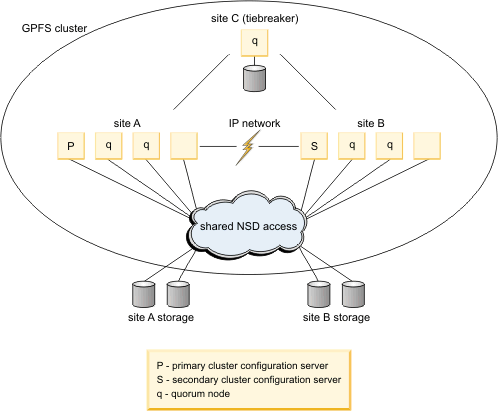Synchronous mirroring with GPFS replication
In a configuration utilizing GPFS™ replication, a single GPFS cluster is defined over three geographically-separate sites consisting of two production sites and a third tiebreaker site. One or more file systems are created, mounted, and accessed concurrently from the two active production sites.
- Separate the set of available disk volumes into two failure groups. Define one failure group at each of the active production sites.
- Create a replicated file system. Specify a replication factor of 2 for both data and metadata.
When allocating new file system blocks, GPFS always assigns replicas of the same block to distinct failure groups. This provides a sufficient level of redundancy allowing each site to continue operating independently should the other site fail.
GPFS enforces a node quorum rule to prevent multiple nodes from assuming the role of the file system manager in the event of a network partition. Thus, a majority of quorum nodes must remain active in order for the cluster to sustain normal file system usage. Furthermore, GPFS uses a quorum replication algorithm to maintain the content of the file system descriptor (one of the central elements of the GPFS metadata). When formatting the file system, GPFS assigns some number of disks (usually three) as the descriptor replica holders that are responsible for maintaining an up-to-date copy of the descriptor. Similar to the node quorum requirement, a majority of the replica holder disks must remain available at all times to sustain normal file system operations. This file system descriptor quorum is internally controlled by the GPFS daemon. However, when a disk has failed due to a disaster you must manually inform GPFS that the disk is no longer available and it should be excluded from use.
- A single quorum node
As the function of this node is to serve as a tiebreaker in GPFS quorum decisions, it does not require normal file system access and SAN connectivity. To ignore disk access errors on the tiebreaker node, enable the unmountOnDiskFail configuration parameter through the mmchconfig command. When enabled, this parameter forces the tiebreaker node to treat the lack of disk connectivity as a local error, resulting in a failure to mount the file system, rather that reporting this condition to the file system manager as a disk failure.
- A single network shared disk The function of this disk is to provide an additional replica of the file system descriptor file needed to sustain quorum should a disaster cripple one of the other descriptor replica disks. Create a network shared disk over the tiebreaker node's internal disk defining:
- the local node as an NSD server
- the disk usage as descOnly
The descOnly option instructs GPFS to only store file system descriptor information on the disk.
This three-site configuration is resilient to a complete failure of any single hardware site. Should all disk volumes in one of the failure groups become unavailable, GPFS performs a transparent failover to the remaining set of disks and continues serving the data to the surviving subset of nodes with no administrative intervention. While nothing prevents you from placing the tiebreaker resources at one of the active sites, to minimize the risk of double-site failures it is suggested you install the tiebreakers at a third, geographically distinct location.
- In an environment that is running synchronous mirroring using GPFS replication:
- Do not designate a tiebreaker node as a manager node.
- Do not mount the file system on the tiebreaker node. To avoid unexpected mounts, you can create
the following file with any content on the tiebreaker
node:
In the following example, the file system is fs1:/var/mmfs/etc/ignoreAnyMount.<file_system_name>
See the article "File System Management" in IBM® developerWorks® at https://www.ibm.com/developerworks/community/wikis/home?lang=en#!/wiki/General%20Parallel%20File%20System%20(GPFS)/page/File%20System%20Management./var/mmfs/etc/ignoreAnyMount.fs1Note: If you create an ignoreAnyMount.<file_system_name> file, you cannot manually mount the file system on the tiebreaker node.
- In a stretch cluster environment, designate at least one quorum node from each site as a manager node. During site outages, the quorum nodes can take over as manager nodes.
- You do not need to create different subnets.
- You do not need to have GPFS nodes in the same network across the two production sites.
- The production sites can be on different virtual LANs (VLANs).
The high-level organization of a replicated GPFS cluster for synchronous mirroring where all disks are directly attached to all nodes in the cluster is shown in Figure 1. An alternative to this design would be to have the data served through designated NSD servers.
With GPFS release 4.1.0, a new, more fault-tolerant configuration mechanism has been introduced as the successor for the server-based mechanisms. The server-based configuration mechanisms consist of two configuration servers specified as the primary and secondary cluster configuration server. The new configuration mechanism uses all specified quorum nodes in the cluster to hold the GPFS configuration and is called CCR (Clustered Configuration Repository). The CCR is used by default during cluster creation unless the CCR is explicitly disabled. The mmlscluster command reports the configuration mechanism in use in the cluster.
The following sections describe the differences regarding disaster recovery for the two configuration mechanisms.
